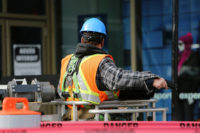A new Associated General Contractors of America survey shows that member firms see some encouraging market signals this year but also indications that 2011 still will be tough.
The 2011 AGC outlook survey report, released on Jan. 24, sums up its findings:
"Despite predictions of slight growth in demand for several key construction sectors and an improving construction employment picture, construction firms are bracing for at least one more difficult year as the benefits of the stimulus begin to fade and overall demand for construction remains weak."
AGC CEO Stephen E. Sandherr said in a conference call with reporters that "while there are some promising, and positive, signs in the outlook, the bottom line is 2011 will not be an easy year for most firms."
"However, it appears that it may be better than last year."
Adding a further upbeat note, Sandherr said that if trends hold, construction "will be in a much better position 12 months from now than it is today."
Nevertheless, the industry first will have to weather 2011.
AGC Chief Economist Ken Simonson said, "Although the picture is improving, the industry is extremely fragile."
Click Here to listen to the conference call.
The survey, which had about 1,300 firms responding, shows some improvements in expected hiring. It says 27% of the companies plan to add workers this year and 20% play layoffs. Last year, 55% of firms laid off workers and only 20% expanded their workforces.
Regarding market-segment health, firms see brightest prospects in hospitals-higher education, with 32% of firms predicting a rise in the dollar volume of projects for which they compete.
The power sector ranks second, with 29% of firms projecting an increase.
But Simonson observes that even in those two segments, more firms foresee volume declining than growing.
On the other end of the scale is private office construction--56% of firms foresee lower volume in that sector this year than in 2010.
Simonson said that "while the overall outlook is not as dreary as we have seen in prior years, the industry is still pushing against some brisk headwinds."
One such headwind is an expected falloff in federal economic-stimulus construction funding in 2011.
For example, nearly all of the highway, airport and sewage-treatment funds provided by the stimulus law--the 2009 American Recovery and Reinvestment Act--are under contract, according to a Jan. 3 report by House Transportation and Infrastructure Committee Democrats, who then were in the chamber's majority.
The AGC survey shows that, depending on the market category, 56% to 66% of responding firms expect stimulus spending to drop this year.
In 2011, 30% of AGC-surveyed firms say they are planning to carry out stimulus-financed projects, compared with 45% in 2009 or 2010.
Sandherr says many contractors that focus on infrastructure markets also are worried about the impact of continued delays on Capitol Hill in passing key bills. Those overdue measures include surface transportation, aviation and water resources.
Looking ahead, another pressure point for contractors is the sweeping health-care bill signed into law last March 23. AGC says 71% of responding firms expect that their health-care expenses will climb this year as a result of that new statute.
Among other survey findings, 55% of companies say they expect to use building information modeling (BIM) on a greater share of their 2011 projects than they did last year. In 2010, they said they used BIM on just 8% of the work, on average.
Construction equipment faces another difficult year, judging from the AGC survey. Only 29% of companies plan to buy new construction equipment this year, a decline from 34% in 2010. But average cost of that equipment is expected to rise to $900,000 per firm, from $671,000 last year.




Post a comment to this article
Report Abusive Comment